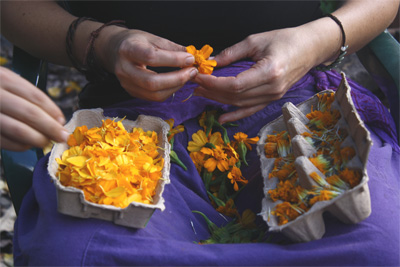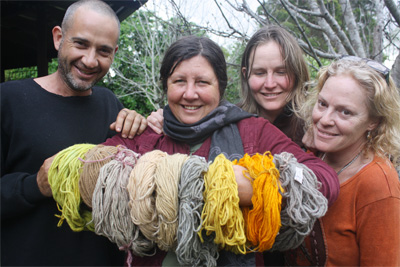Graduate Stories
Natural Dyes From Your Own Backyard
 Natural Dye Workshop at Djangbung Gardens
Natural Dye Workshop at Djangbung Gardens
“Natural dying is one skill that is easy, at little cost and is a fun method of recycling and renewing.”
Earlier this year I teamed up with Janelle (teacher at Djangbung) to research and produce natural Dyes that could be taught in a 2 hour workshop. The aim was that any participant that attended the workshop would walk away from it with the skills and knowledge to; recognize suitable plants for dying, understand the process of mordents and assistants, have heaps of fun experimenting with a great range of colours and to find the joy in turning something possibly old and dull into a new colourful creative expression naturally!
 With Janelle`s previous experience in dying and both our recent research we set off to collect the ingredients which included the fibres (wool, cotton and hemp), pots, spoons, heat source, jugs, buckets, mordents and assistants. Then off into the bush at Janelle`s place for some barks, raiding Djangbung gardens for marigolds and mulberries, a collection of onion skins from the pub and other helpful people, and a slippery muddy dam adventure for the roots of a weedy water lily plus many more plants.
With Janelle`s previous experience in dying and both our recent research we set off to collect the ingredients which included the fibres (wool, cotton and hemp), pots, spoons, heat source, jugs, buckets, mordents and assistants. Then off into the bush at Janelle`s place for some barks, raiding Djangbung gardens for marigolds and mulberries, a collection of onion skins from the pub and other helpful people, and a slippery muddy dam adventure for the roots of a weedy water lily plus many more plants.
From our forage around Djangbung gardens and Janelle`s place we collected quite a range of plants producing colours from bright yellow, lime green, grey and many earthy browns and reds. We also have a woad plant growing at Djangbung that will produce a range of blues and purples.
I think that at this time it`s important for people to hone in on traditional skills using natural resources to reduce waste and to recognise that natural dying is one skill that is easy, at little cost and is a fun method of recycling and renewing.
Report by Shlley Clements

Natural dyes will be added to the 2011 program, which will be taught in the core units of the Cert III Cert IV and Dip levels at the Permaculture College Australia by Janelle Schafer.
|
COMMON NAME |
BOTANIC NAME |
PLANT PART USED |
MORDANT |
COLOUR |
|
Blackberry |
Rubus species |
young shoots |
alum |
creamy fawn |
|
Bracken |
Pteridium aquilinum |
young shoots |
alum |
yellowish green |
|
Comfrey |
Symphytum officinale |
fresh green plant |
alum |
yellow |
|
Marigold |
Calendula officinalis |
petals |
alum, cream of tartar |
pale yellow |
|
Onion |
Allium cepa |
skins |
alum, cream of tartar |
orange |
|
Parsley |
Roselinum |
fresh leaves and stems |
alum |
cream |
|
Privet |
Ligustrum vulgare |
ripe berries |
alum |
greyish green |
|
Sorrel |
Rumex acetosa |
roots |
alum |
soft pink |
|
Tumeric |
Curcuma longa |
powdered roots |
alum |
gold – orange |
|
Woad |
Isatis tinctoria |
leaves |
sodium dithionite, ammonia |
blue |
|
or urine |
||||



